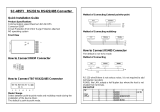
6 Chromalox 3101 Operator's Manual
Good Wiring Practices
1. When planning the system wiring, separate
wiring into functionally similar bundles - i.e. power
leads, sensor leads, output signal lines, etc. If the
power leads and sensor leads must cross, they
should cross at a 90° angle to each other (perpen-
dicular).
2. Locate all sources of electrical noise in your
system, and separate these sources from the
control systems—motors, contacts, solenoids,
etc. Electrical noise can affect the function of any
control system. When driving a contactor coil or
other inductive load, an appropriately rated AC
snubber circuit is recommended (Chromalox Part.
No. 0149-01305), as described on page 11, “Re-
lay Output Wiring.”
3. For sensor wiring practices, see Sensor Wiring
Notes, next page.
4. Additional information on good wiring practices
is available from IEEE, 345 East 47th St., NY, NY
10017. Request IEEE Standard No. 518-1982.
Make all electrical wiring connections to the back
of the controller before power is applied to the
unit.
All wiring must comply with local codes, regula-
tions and ordinances. This instrument is intended
for panel mounting and the terminals must be
enclosed within a panel. Use National Electric
Code (NEC) Class 1 wiring for all terminals except
the sensor terminals.
Check the wiring decal on the side of the unit to
verify the model number. The wiring decal shows
the wiring terminations. All wires will be connect-
ed to the terminals on the back of the instrument
case. Specifi c wiring instructions for different
input and output types are given in this section.
Wiring
Instructions






















